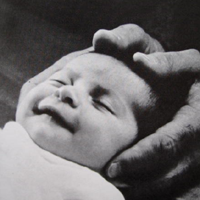
Psychoanalysis
The Damaged Bond of Attachment
by Marc-André Cotton
Lecture given at the 27th Congress of the French Federation of Psychotherapy and Psychoanalysis “Attachment, empathy and childreadring violence” (Octobre 20, 2011). Clic here to read the original French article.
Abstract: The child lives in a continuity of consciousness. It’s the loss of his/her mother’s attachment that disconnects him/her from that state and progressively confines the child in neurosis, as shown by the examples of Sigmund Freud and Donald Winnicott.

We all agree that the first months of life are a critical phase for the newborn and his/her mother to bond together. Biology and ethology also show that deprivation of attachment bears dire consequences to the psychological and affective development of the infant. The obstetrician Michel Odent tells us that our babies are mammals. His book Le Bébé est un mammifère has just been reissued by the French publisher l’Instant présent.
Some professionals and parents are already recommending breastfeeding on demand, skin to skin contact, co-sleeping, the joy of being together until infants acquire their autonomy step by step. But those suggestions are not widely heard because they face a complex structure: the human neurosis.
One can wonder why we strayed from the typical mammal behavior to the point of threatening our survival and the balance of our children. Probably so that one day we can restore our biological dimension in full awareness. Let’s ask then:
- From what point on can a baby be considered conscious?
- From what point on does the reflexive consciousness that characterizes the human being show up in the child?
Certainly since always, because the child lives in a continuity! When he looks for his mother’s breast, he sets the bases of his relationship to others. When he says his first words, he already has the structure of human language. Therefore, not satisfying a baby in his most essential needs is hampering the harmonious development of his reflexive consciousness. When unsatisfied, the infant displays his unease with cries, shouts: he knows it’s vital for him. That too, is an expression of his conscious nature.
If not heard, he uses his immature brain to manage his pain by repressing it. Remember, nature has a Plan B! The infant makes up compensation schemes and models his thought patterns on his parents’. This means that he remains keen on showing what was an obstacle to the fulfillment of his consciousness, which still is an expression of his conscious nature!
Once he becomes an adult, if he doesn’t find any space to put words on his sufferings, i.e. an enlightened witness, as Alice Miller puts it, he locks himself into neurosis. Don’t we sometimes say about neurotic persons that they are stuck at an infantile stage? The process of attachment of a baby to his mother takes place in a larger natural process that is the fulfillment of his consciousness. As Olivier Maurel suggests about the consequences of ordinary disciplinary violence, the consequence of severing the attachment bond forms a kind of “blind spot” in human sciences that is the hallmark of traumatism.
I would like to illustrate that deprivation with two examples: first Freud, then the English psychoanalyst Donald Winnicott. In one of his Three Essays on the Theory of Sexuality, published in 1905, Freud states that the child bears in himself a predisposition to perversity. Everyone knows that freudian quote, here in context (page 57):
“It is an instructive fact that under the influence of seduction children can become polymorphously perverse, and can be led into all possible kinds of sexual irregularities. This shows that an aptitude for them is innately present in their disposition.”
It’s a circular reasoning—nowadays one would say “projective”—that says: If the child can become perverse, then he is prone to it by nature… There is no distance, no reflection on the part of the founder of psychoanalysis. By the way, let’s notice that he mentions the seduction theory, which he gave up eight years earlier, but whose hints still remain. As a well-known phallocrat, he hastily generalizes his point to women, and eventually to mankind as a whole:
“In this respect children behave in the same kind of way as an average uncultivated woman in whom the same polymorphously perverse disposition persists… Prostitutes exploit the same polymorphous that is, infantile, disposition for the purposes of their profession [and for that reason] it becomes impossible not to recognize that this same disposition to perversions of every kind is a general and fundamental human characteristic.”
What is the “blind spot” in Freud’s thought process that makes him sum up the human being to an essentially perverse being? It’s the absence of attachment! He hasn’t experienced unconditional acceptance of a mother for her newborn child, nor skin to skin contact, nor breastfeeding on demand. For the high society of Vienna to which he belonged, such welcoming of a child’s needs was widely condemned. Unconsciously, Freud bears that condemnation and he shows it by dooming the child as perverse. However, his consciousness “knows” that an essential part of his being has been condemned and reenacts that condemnation. Freud goes further, stating that the child is prone to use any kind of manipulation to obtain from others the pleasure that he is forced to obtain by himself. If Freud insists on that loneliness of the child, isn’t it because he himself experienced it and suffered from it as a child?
On to the second example, Winnicott, the founder of child psychoanalysis in Britain. He is a great pediatrician who worked to acknowledge babies as persons in their most essential needs. What does he write in The Child, the Family and the Outside World, published in 1957? He states that he detects in the breastfed baby an aggressive impulse that reveals itself, according to him, as a ruthless attack on the breast and eventually on the mother. Page 53 reads as follow:
“There is a very strong aggressive element in the primitive love impulse which is the feeding impulse. In terms of the fantasy of a slightly later date the mother is ruthlessly attacked, and although but little aggression may be observable it is not possible to ignore the destructive element in the aim of the infant.”
Oddly enough, these reflections have been removed from the French edition and replaced by a more consensual text from 1949. There again, Winnicott, who grew up in the Victorian bourgeoisie, talks about his own infancy. His depressed mother didn’t offer him her unconditional acceptance. She left him to a wet nurse, then to a governess. In his psychoanalytic work, Winnicott pushes forward the importance of the relation to the mother, and creates concepts such as “good enough mother” or “ordinary devoted mother” by which he idealizes his own mother. There is his “blind spot”, a repressed pain resulting from the loss of attachment.
Winnicott refuses to blame his mother so he accuses the baby of being fundamentally aggressive. Like Freud, he imparts on the child a hostile drive that truly lays in the mother who suffered herself from a loss of attachment. In the therapeutic circles, we know well these projective defensive mechanisms, but may yet give in to them all too easily! The more so when we haven’t—or not enough—revisited our own infancy.
Finally, I’d like to say a word about the recent modification of the French law on the practice of psychotherapy, which can be seen as a present-day illustration. As you know, the qualification of psychotherapist—with some exceptions—is now limited to doctors, and psychologists, without them having to experience a psychotherapy for themselves. That is to say these professionals will not have to revisit their “blind spots”, nor experience the helplessness triggered by the loss of attachment, nor will they have to question their parents and their education before having clients themselves.
Let’s hope that eventually those clients will notice that what makes a good therapist is not his university degrees, but rather his ability to acknowledge in them this damaged bond of attachment.
Thank you.
Marc-André Cotton
(Translated from French by A. Cabanillas)
© M. A. Cotton 10.2011 / regardconscient.net
